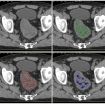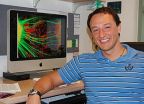Mapping the spread of diarrhea bacteria a major step towards new vaccine
2014-11-11
(Press-News.org) Enterotoxigenic Escherichia coli (ETEC) bacteria are responsible each year for around 400 million cases of diarrhoea and 400,000 deaths in the world's low- and middle-income countries. Children under the age of five are most affected.
ETEC bacteria also cause diarrhoea in nearly one in two travellers to these areas.
Major breakthrough
Researchers at the University of Gothenburg's Sahlgrenska Academy are world leaders in research into ETEC and have now made a major breakthrough in collaboration with colleagues from the Wellcome Trust Sanger Institute in the UK, Karolinska Institutet in Sweden and universities in Japan, Germany and the USA, among others.
A study published in Nature Genetics details how the Gothenburg researchers used comprehensive DNA analyses to reveal the ETEC bacteria's genetic composition - an analysis that also makes it possible to map how the bacteria spread.
Of global benefit
"We can see that some of the dangerous strains of ETEC derive from a single bacterium that has divided and spread right around the world," says Astrid von Mentzer, doctoral student at the Sahlgrenska Academy. "This may sound like bad news, but it actually means that the vaccine that we are developing on the basis of the most common types of bacteria will be of global benefit."
Largets collection of strains
The University of Gothenburg is home to the world's largest collection of strains of ETEC bacteria, comprising more than 3,500 strains from around the world. The present study saw the researchers focusing on a total of 362 strains, which were isolated from children, adults and travellers affected by diarrhoea in Africa, Asia and Latin America in the last 30 years.
"The analysis shows that children, adults and travellers are all affected to the same extent by diarrhoea caused by the different strains of ETEC," says Astrid von Mentzer. "Which would suggest that the vaccine could work for all three groups."
174 years old
The researchers were also able to demonstrate in the study that some of the ETEC groups identified came into existence as far back as 174 years ago. Astrid von Mentzer feels that this new information about the genetic composition of ETEC bacteria and how they spread means that we are a step closer to reducing the prevalence of diarrhoeal diseases worldwide.
The research project is a successful collaboration between the University of Gothenburg and the Wellcome Trust Sanger Institute in Cambridge in the UK, which is a world leader in sequencing.
INFORMATION:
The article Identification of enterotoxigenic Escherichia coli (ETEC) clades with long-term global distribution was published in Nature Genetics on 10 November.
Link to the journal: http://www.nature.com/ng/index.html
Contact:
Astrid von Mentzer, doctoral student at the Sahlgrenska Academy, University of Gothenburg
+46 (0)769 410 890
+46 (0)31 786 62 21
astrid.von.mentzer@gu.se
Åsa Sjöling, researcher at Karolinska Institutet
+46 (0)702 345 815
asa.sjoling@ki.se
Image above: The research on a new diarrhea vaccine is done in close collaboration with researchers and local people in Dhaka, Bangladesh. Many children in Dhaka lack clean water and proper toilets. ETEC diarrhea and other diseases are very common.
[Attachments] See images for this press release:


ELSE PRESS RELEASES FROM THIS DATE:
2014-11-11
As football players are learning, a violent blow to the head has the potential to cause mild to severe traumatic brain injury -- physical damage to the brain that can be debilitating, even fatal. The long-term effects run the gamut of human functioning, from trouble communicating to extensive cognitive and behavioral deterioration. To date, there is no effective medical or cognitive treatment for patients with traumatic brain injuries.
But a new study from Tel Aviv University researchers points to an "enriched environment" -- specially enhanced surroundings -- as a promising ...
2014-11-11
Technology developed at the University of Sussex helps hospitals make earlier and more accurate treatment decisions and survival assessments for patients with bowel cancer.
Bowel cancer kills more than 16,000 people a year in the UK, making it the nation's second-most common cause of cancer death (after lung cancer).
A novel medical-imaging technology, TexRAD, which analyses the texture of tumours, has been shown in trials to enable early diagnosis of those bowel-cancer patients not responding to the standard cancer therapy better than other available tumour markers. ...
2014-11-11
Changes to China's drink driving laws are catching the community off guard with more than 70 per cent of people unaware of the blood alcohol limits that could see them face criminal charges, according to new Queensland University of Technology (QUT) research conducted in two Chinese cities.
QUT's Centre for Accident Research & Road Safety - Queensland (CARRS-Q) has partnered with organisations in China to promote road safety and reduce fatalities and injuries, as alcohol-related driving offences are being brought into sharper focus because of the country's rapid motorisation ...
2014-11-11
A new climate change modeling tool developed by scientists at Indiana University, Princeton University and the National Oceanographic and Atmospheric Administration finds that carbon dioxide removal from the atmosphere owing to greater plant growth from rising CO2 levels will be partially offset by changes in the activity of soil microbes that derive their energy from plant root growth.
Soils hold more carbon than all of the earth's plant biomass and atmosphere combined. The new work published by Benjamin N. Sulman, a postdoctoral researcher in the lab of co-author and ...
2014-11-11
INDIANAPOLIS -- A new treatment regimen for hepatitis C, the most common cause of liver cancer and transplantation, has produced results that will transform treatment protocols for transplant patients, according to research published online today in the New England Journal of Medicine.
The investigational three-drug regimen, which produced hepatitis C cure rates of 97 percent, is an oral interferon-free therapy. Previously, the typical treatment for hepatitis C after a liver transplant was an interferon-based therapy, usually given for 48 weeks. It had a much lower response ...
2014-11-11
Lead researcher, Dr Sarah Dunstan from the Nossal Institute of Global Health at the University of Melbourne said the study is the first large-scale, unbiased search for human genes that affect a person's risk of typhoid.
Enteric fever, or typhoid fever as it more commonly known, is a considerable health burden to lower-income countries.
This finding is important because this natural resistance represents one of the largest human gene effects on an infectious disease.
"We screened the human genome to look for genes associated with susceptibility to, or resistance ...
2014-11-11
Weeds in the UK are still evolving hundreds of years after their introduction and are unlikely to have yet reached their full potential as invaders, UNSW Australia scientists have discovered.
The study is the first to have tracked the physical evolution of introduced plant species from the beginning of their invasion to the present day, and was made possible by the centuries-old British tradition of storing plant specimens in herbaria.
The research team, led by Habacuc Flores-Moreno, looked at three common weeds - Oxford ragwort, winter speedwell and a willow herb - which ...
2014-11-11
A controversial medication used by breastfeeding women should not be restricted because of the benefits it offers mothers and their babies, according to researchers at the University of Adelaide.
The medication domperidone has recently been the subject of warnings from the European Medicines Agency based on research that there is a link between the medication and fatal heart conditions.
Domperidone has been banned in the United States for years because of fatal cardiac arrhythmias among cancer patients who had been prescribed the drug to prevent nausea and vomiting.
However, ...
2014-11-11
This news release is available in German. X-rays are widely used in medicine and in materials science. To take a picture of a broken bone, it is enough to create a continuous flux of X-ray photons, but in order to study time-dependent phenomena on very short timescales, short X-ray pulses are required. One possibility to create short hard X-ray pulses is hitting a metal target with laser pulses. The laser rips electrons out of the atoms and makes them emit X-ray radiation. Electrical engineers at the Vienna University of Technology (TU Wien) together with researchers ...
2014-11-11
With the help of mouse models, induced pluripotent stem cells (iPSCs) and the "tooth fairy," researchers at the University of California, San Diego School of Medicine have implicated a new gene in idiopathic or non-syndromic autism. The gene is associated with Rett syndrome, a syndromic form of autism, suggesting that different types of autism spectrum disorder (ASD) may share similar molecular pathways.
The findings are published in the Nov. 11, 2014 online issue of Molecular Psychiatry.
"I see this research as an example of what can be done for cases of non-syndromic ...
LAST 30 PRESS RELEASES:
[Press-News.org] Mapping the spread of diarrhea bacteria a major step towards new vaccine








